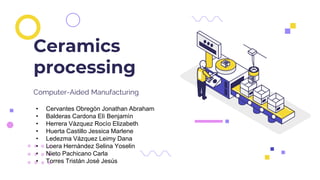
CeramicsProcessing.pptx
- 1. Ceramics processing Computer-Aided Manufacturing • Cervantes Obregòn Jonathan Abraham • Balderas Cardona Elì Benjamìn • Herrera Vàzquez Rocìo Elizabeth • Huerta Castillo Jessica Marlene • Ledezma Vázquez Leimy Dana • Loera Hernàndez Selina Yoselin • Nieto Pachicano Carla • Torres Tristán José Jesús
- 2. Shaping ceramics Several techniques are available for processing ceramics into useful products depending on the type of ceramics involved and their shapes. Production of some ceramic parts not involve the same level of control of materials and processes as do high-tech components and cutting tools (using, for example, aluminum oxide). Generally, however, the procedure involves the following steps: I. Crushing or grinding the raw materials into very fine particles II. Mixing them with additives to impart certain desirable characteristics III. Shaping, drying, and firing the material.
- 3. Ceramics may be subjected to additional processing, such as machining and grinding, for better control of dimensions and surface finish. The first step in processing ceramics is the crushing of the raw materials. Crushing generally is done in a ball mill, either dry or wet. Wet crushing is more effective, because it keeps the particles together and also prevents the suspension of fine particles in the air. The ground particles are then mixed with additives-the functions of which are one or more of the following:
- 4. 01 Binder For holding ceramic particles together 02 Lubricant To reduce internal friction between particles during molding and to help remove the part from the mold 03 Wetting agent To improve mixing 04 Plasticizer To make the mix more plastic and formable 05 Agents To control foaming and sintering. 06 Deflocculent To make the ceramic- water suspension more uniform by changing the electrical charges on the particles of clay
- 5. Casting
- 6. The most common casting process is slip casting (also called drain casting). A slip is a suspension of colloidal ceramic particles in an immiscible liquid, which isgenerally water.
- 8. Plastic forming (also called soft, wet, or /vydroplastic forming) can be carried out by various methods, such as extrusion, injection molding, or molding and jiggering. Plastic forming tends to orient the layered structure of clay along the direction of material flow and, hence, tends to cause anisotropic behavior of the material both in subsequent processing and in the final properties of the ceramic product. In extrusion, the clay mixture (containing 20 to 30% water) is forced through a die opening by a screw-type piece of equipment.
- 9. Pressing
- 10. Dry Pressing. This is a technique similar to powder-metal compaction, as described in Section. Dry pressing is used for relatively simple shapes, such as Whitevvare, refractories for furnaces, and abrasive products. The moisture content of the mixture generally is below 4%, but it may be as high as 12%. Organic and inorganic bind ers (such as stearic acid, Wax, starch, and polyvinyl alcohol) usually are added to the mixture; these additives also act as lubricants.
- 11. Wet Pressing. In wet pressing, the part is formed in a mold while under high pressure in a hydraulic or mechanical press. This process generally is used to make intricate shapes. Moisture content usually ranges from 10 to 15%. lsostatic Pressing. Used extensively in powder metallurgy, isostatic pressing also is used for ceramics in order to obtain a uniform density distribution throughout the part during compaction. Jiggering. A series of steps is needed to make ceramic plates. First, clay slugs are extruded and formed into a but over a plaster mold.
- 12. Injection Molding. Injection molding is used extensively for the precision forming of ceramics in high-technology applications, such as for rocket-engine components. Hot Pressing. In this process (also called pressure sintering), the pressure and the heat are applied simultaneously, thereby reducing porosity and making the part denser and stronger.
- 13. Pressing
- 14. The next step in ceramic processing is to dry and fire the part to give it the proper strength and hardness. Drying is a critical stage because of the tendency for the part to Warp or crack from variations in moisture content and in thickness. Control of atmospheric humidity and of ambient temperature is important in order to reduce warping and cracking. Loss of moisture during drying causes shrinkage of the part by as much as 20% from the original, moist size.
- 16. Because firing causes dimensional changes, additional operations may be performed to (a) give the ceramic part its final shape, (b) improve its surface finish and dimensional tolerances, and (c) remove any surface flaws. Although they are hard and brittle, major advances have been made in producing machinable ceramics and grindable ceramics, thus enabling the production of ceramic components with high dimensional accuracy and a good surface finish.
- 17. 01 Grinding (using a diamond wheel) 02 Lapping and honing 03 Ultrasonic machining 04 Drilling (using a diamond-coated drill) 05 Electrical- discharge machining 06 Laser-heam machining 07 Abrasive water-jet cutting 08 Tumbling (to remove sharp edges and grinding marks)